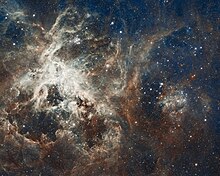Fil:30 Doradus, Tarantula Nebula.jpg

Størrelse på denne forhåndsvisningen: 749 × 599 piksler. Andre oppløsninger: 300 × 240 piksler | 600 × 480 piksler | 960 × 768 piksler | 1 280 × 1 024 piksler | 2 560 × 2 048 piksler | 20 323 × 16 259 piksler.
Opprinnelig fil (20 323 × 16 259 piksler, filstørrelse: 99,35 MB, MIME-type: image/jpeg)
Filhistorikk
Klikk på et tidspunkt for å vise filen slik den var på det tidspunktet.
| Dato/klokkeslett | Miniatyrbilde | Dimensjoner | Bruker | Kommentar | |
|---|---|---|---|---|---|
| nåværende | 8. jul. 2012 kl. 20:35 |  | 20 323 × 16 259 (99,35 MB) | Prof. Professorson | Higher resolution, converted from http://spacetelescope.org/static/archives/images/original/heic1206a.tif. |
| 19. apr. 2012 kl. 14:13 |  | 2 340 × 1 847 (2,52 MB) | Dipankan001 |
Filbruk
De følgende 10 sidene bruker denne filen:
- Wikipedia:Underprosjekter/Astronomi
- Wikipedia:Underprosjekter/Astronomi/Artikler
- Wikipedia:Underprosjekter/Astronomi/Diskusjon
- Wikipedia:Underprosjekter/Astronomi/Hjelp
- Wikipedia:Underprosjekter/Astronomi/Medlemmer
- Wikipedia:Underprosjekter/Astronomi/Nyheter
- Wikipedia:Underprosjekter/Astronomi/Oppgaver
- Wikipedia:Underprosjekter/Astronomi/Topp
- Wikipedia:Underprosjekter/Astronomi/Vurdering
- Wikipedia:Underprosjekter/Astronomi/Wikidata
Global filbruk
Følgende andre wikier bruker denne filen:
- Bruk i af.wikipedia.org
- Bruk i ar.wikipedia.org
- Bruk i be-tarask.wikipedia.org
- Bruk i bn.wikipedia.org
- Bruk i crh.wikipedia.org
- Bruk i cs.wikipedia.org
- Bruk i cv.wikipedia.org
- Bruk i de.wikipedia.org
- Bruk i en.wikipedia.org
- Starburst region
- Wikipedia:WikiProject Astronomy/Recognized content
- Wikipedia:Featured pictures/Space/Looking out
- Wikipedia:Teahouse/Guests
- Wikipedia:Teahouse/Guest profile summary
- Wikipedia:Teahouse/Guest profile summary/Avatars
- Wikipedia:Teahouse/Guests/Left column
- Wikipedia:Teahouse/Guests/Right column
- User:The Determinator/Userpage/Top/Image
- Wikipedia:WikiProject Astronomy/Recognized astronomy content
- Wikipedia:Teahouse/Guest/Featured/21
- Wikipedia:Teahouse/Guest/Featured/22
- Wikipedia:Teahouse/Guest book/Archive 13
- Wikipedia:Teahouse/Guest book/Archive 14
- Wikipedia:Teahouse/Guest book/Archive 15
- Wikipedia:Teahouse/Guest book/Archive 16
- Wikipedia:Teahouse/Guest book/Archive 17
- Wikipedia:Teahouse/Guest book/Archive 18
- Wikipedia:Teahouse/Guest book/Archive 19
- Wikipedia:Teahouse/Guest book/Archive 20
- Wikipedia:Teahouse/Guest book/Archive 22
- Wikipedia:Teahouse/Guest book/Archive 23
- Wikipedia:Teahouse/Guest book/Archive 24
- Wikipedia:Teahouse/Guest book/Archive 26
- Wikipedia:Teahouse/Guest book/Archive 28
- Wikipedia:Teahouse/Guest book/Archive 29
- Wikipedia:Teahouse/Guest book/Archive 30
- Wikipedia:Teahouse/Guest book/Archive 31
- Wikipedia:Teahouse/Guest book/Archive 32
- Wikipedia:Teahouse/Guest book/Archive 34
- Wikipedia:Teahouse/Guest book/Archive 35
- Wikipedia:Teahouse/Guest book/Archive 36
- Wikipedia:Teahouse/Guest book/Archive 37
- Wikipedia:Teahouse/Guest book/Archive 39
- Wikipedia:Teahouse/Guest book/Archive 40
- User:LucasTichawa
- Wikipedia:Teahouse/Guest book/Archive 42
- Wikipedia:Teahouse/Guest book/Archive 43
- Wikipedia:Teahouse/Guest book/Archive 44
- Wikipedia:Teahouse/Guest book/Archive 45
- Wikipedia:Teahouse/Guest book/Archive 0
Vis mer global bruk av denne filen.



